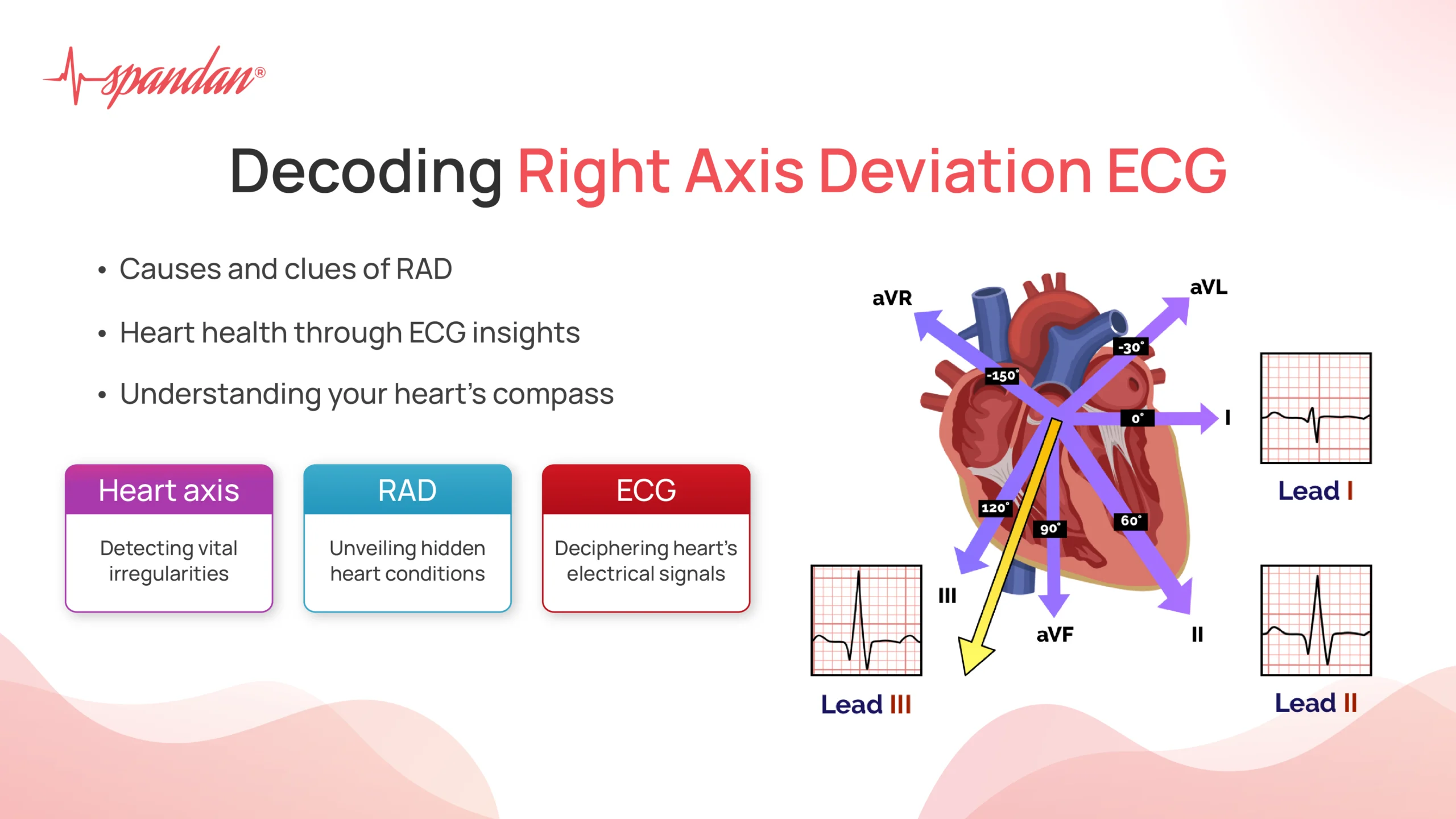
Author:- Mr. Ritesh Sharma
As you must already know an electrocardiogram test using an ECG machine detects the electrical activity of the heart over a period of time. One interesting aspect of this test is that consists of an electrical axis. This electrical axis is sometimes shifted to the right of its expected position, this ECG is referred to as the right axis deviation ECG. This deviation from the normal position of the electrical axis of an ECG is an extremely nuanced entity in the domain of cardiac care.
To understand the right axis deviation ECG, one needs to know the cardiac anatomy, physiology, and electrical conduction pathways. In this blog, we will try to cover all the facets of the right axis deviation ECG. So, all healthcare professionals and general people alike who are willing to learn about this unique deviation from the normal ECG test will find worthy information in this blog.
Anatomy and Physiology of Right Deviation ECG
To comprehend right axis deviation ECG, let’s first revisit the basics of cardiac anatomy and physiology. The heart comprises four chambers: two atria and two ventricles. Electrical impulses generated by the sinoatrial (SA) node i.e. the natural pacemaker of the heart initiate each heartbeat, traveling through specialized conduction pathways. These impulses coordinate atrial and ventricular contractions, leading to efficient blood circulation.
Electrical Conduction of Right Axis Deviation ECG
The heart’s electrical activity can be visualized through an ECG. This graphical representation records the electrical potential generated by cardiac depolarization and repolarization. The P wave reflects atrial depolarization, followed by the QRS complex representing ventricular depolarization, and finally, the T wave reflecting ventricular repolarization.
Understanding Axis
The electrical axis refers to the overall direction of cardiac depolarization during ventricular contraction. It’s represented on the ECG as the net direction of the QRS complex. Normally, the axis runs from the atria to the ventricles in a downward and leftward direction (between -30 to +90 degrees). RAD occurs when this axis shifts rightward, deviating beyond +90 degrees.
Causes of Right Axis Deviation ECG
RAD can stem from various cardiac and non-cardiac factors. Common cardiac causes include:
- Right Ventricular Hypertrophy (RVH): Increased workload on the right ventricle, often due to pulmonary hypertension, can lead to RAD.
- Chronic Lung Disease: Conditions like chronic obstructive pulmonary disease (COPD) can cause RAD due to chronic hypoxia and pulmonary hypertension.
- Congenital Heart Disease: Certain congenital defects, such as atrial septal defects or tetralogy of Fallot, may result in RAD.
- Acute Pulmonary Embolism: RAD can manifest acutely in the presence of a massive pulmonary embolism due to acute strain on the right heart.
- Right Bundle Branch Block (RBBB): This conduction abnormality can lead to RAD, as depolarization is delayed in the right ventricle.
- Hyperkalemia: Elevated serum potassium levels can alter cardiac conduction, potentially resulting in RAD.
Interpreting Right Axis Deviation ECG
Identifying RAD on an ECG requires a systematic approach. The following steps can aid in interpretation:
- Assess the QRS Axis: Determine the overall direction of the QRS complex by analyzing its amplitude and deflection in leads I and aVF.
- Examine Lead Patterns: RAD is confirmed if the QRS axis deviates beyond +90 degrees. This is typically seen as predominantly positive QRS complexes in lead II and predominantly negative complexes in lead aVR.
- Evaluate for Associated Abnormalities: Look for accompanying signs of RVH, such as right axis deviation with tall R waves in V1 and deep S waves in V6.
- Consider Clinical Context: Understand the patient’s medical history and clinical presentation to correlate ECG findings with underlying pathology.
Differential Diagnosis
When encountering Right Axis Deviation (RAD) on an ECG, it’s essential to consider a broad spectrum of differential diagnoses to guide further evaluation and management.
1. Right Ventricular Hypertrophy (RVH):
- ECG Findings: RAD with tall R waves in V1 and deep S waves in V6, along with right axis deviation.
- Clinical Correlation: Assess for signs of pulmonary hypertension, such as dyspnea on exertion or peripheral edema.
2. Chronic Lung Disease:
- ECG Findings: RAD secondary to chronic hypoxia and pulmonary hypertension.
- Clinical Correlation: Evaluate for symptoms of underlying lung disease, such as chronic cough or exertional dyspnea.
3. Congenital Heart Disease:
- ECG Findings: RAD may be present in certain congenital defects affecting the heart’s structure and function.
- Clinical Correlation: Consider the possibility of congenital heart anomalies based on the patient’s age and clinical history.
4. Acute Pulmonary Embolism:
- ECG Findings: RAD may occur acutely in the setting of a massive pulmonary embolism.
- Clinical Correlation: Prompt assessment for signs of pulmonary embolism, including chest pain, dyspnea, and hemodynamic instability.
5. Right Bundle Branch Block (RBBB):
- ECG Findings: RAD can be associated with delayed depolarization of the right ventricle in RBBB.
- Clinical Correlation: Evaluate for underlying cardiac pathology and monitor for signs of progression, such as worsening heart failure.
6. Hyperkalemia:
- ECG Findings: RAD may be observed in the presence of hyperkalemia, reflecting altered cardiac conduction.
- Clinical Correlation: Assess serum electrolyte levels and consider potential causes of hyperkalemia, such as renal dysfunction or medication side effects.
Clinical Implications of Right Axis Deviation ECG
Right Aixs Deviation ECG can provide valuable diagnostic clues and guide further evaluation. Depending on the clinical scenario, additional investigations such as echocardiography, chest X-ray, or laboratory tests may be warranted to elucidate the underlying cause.
In conclusion, decording Right Axis Deviation in ECG requires a comprehensive understanding of cardiac anatomy, physiology, and electrical conduction. By recognizing the subtle shifts in electrical axis, clinicians can uncover important insights into cardiac function and pathology. Through diligent interpretation and correlation with clinical findings, ECG remains a powerful tool in the diagnosis and management of cardiovascular disorders.




